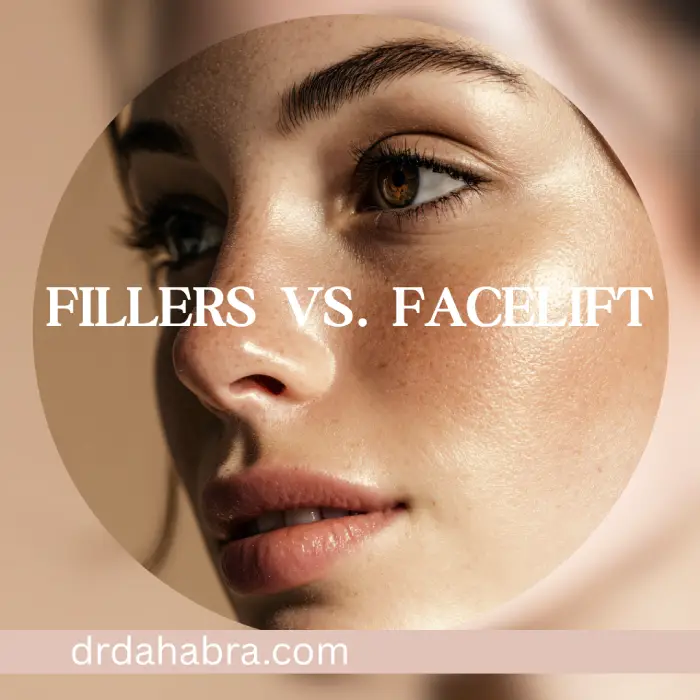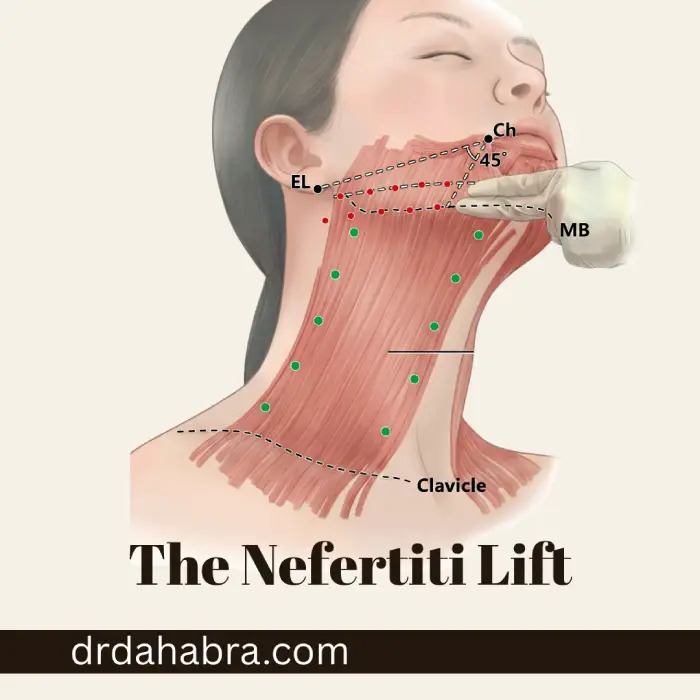Facelift vs. Fillers: Can Injectables Truly Replace Cosmetic Surgery for Sagging Skin?
What is the core difference between a facelift and dermal fillers?
When you ask, “Can Fillers Replace a Surgical Facelift?” it’s essential to understand what each actually does. Fillers, often hyaluronic acid or other gel‑based substances, primarily address volume loss.
They plump hollowed areas, smooth out wrinkles, and restore some facial contours. A facelift, by contrast, is a surgical procedure that targets skin laxity, loose underlying muscle and fat pads, and excess skin.
So while fillers fill, a facelift lifts and repositions.
In other words, fillers are great for “adding” where something has been lost; a surgical facelift is about “removing” or “re‑anchoring” what has sagged or loosened. That’s why a nonsurgical facelift alternative (like a “liquid facelift”) can only go so far.
Because of that fundamental difference, fillers cannot fully replace a surgical facelift, especially when the primary problem is sagging, jowls, a poorly defined jawline, or neck laxity. That key point underpins the comparison of “facelift vs fillers” and is echoed by many experts.
Table of Contents
1. What can fillers do for your aging face?
2. What can a facelift do that fillers cannot?
3. When should you choose fillers (nonsurgical facelift alternative)?
4. When should you consider a facelift for moderate to severe sagging skin, deep folds, and a desire for more dramatic and long‑lasting results?
5. Combination therapy may be an option, as fillers can be used to complement a facelift by adding volume that surgery does not address.
6. Facelifts are more invasive, require more prolonged recovery, and have higher upfront costs, but their effects last 7–10 years or longer, whereas fillers require frequent maintenance and touchups.
7. How does cost compare: liquid facelift cost, surgical facelift cost breakdown, and facelift vs fillers 10-year cost?
8. How long do results last: filler vs facelift longevity?
9. What are the risks of repeated filler use, including filler migration, filler fatigue signs, and the “over‑filled” look?
10. What signs of aging do fillers treat best (volume loss vs skin laxity)?
11. At what point are fillers no longer enough, and a facelift becomes necessary?
12. Can fillers lift sagging skin effectively (fillers for sagging skin, fillers for sagging jowls)?
13. How does prior filler use affect a future facelift (deep plane facelift after fillers, recovering from facelift after fillers)?
14. What are the surgical facelift alternatives (mini facelift, thread lift, nonsurgical facelift options, skin tightening procedures, permanent facelift alternatives)?
15. Frequently Asked Questions (FAQs)
16. Conclusion
17. References
1. What can fillers do for your aging face?
Fillers (including hyaluronic acid fillers) are most effective when the primary concerns are volume loss, such as hollow temples, sunken cheeks, nasolabial folds, lip thinning, or mild jowl “collapse.” They restore lost volume to areas like the cheeks and lips, soften wrinkles and fine lines, and improve facial contours.
Many people think of fillers as a “liquid facelift”, but technically, they’re a volume replacement, not a lift. They don’t reposition sagging tissue or tighten lax skin; they fill and support from below.
Because fillers are minimally invasive, require no large incisions, have comparatively little downtime, and can be done in an outpatient setting, they are attractive as early or mild interventions. They work well for early signs of aging, when volume loss is your primary concern rather than excess skin or heavy sagging.
2. What can a facelift do that fillers cannot?
A surgical facelift can tighten loose skin, lift and reposition underlying muscles and fat pads, and remove excess skin from the face and neck. It addresses the structural and positional changes of aging, things that fillers cannot correct.
For example, when you have jowls, a sagging neck, vertical neck bands, or skin that has lost its elastic support, injections alone often won’t achieve the needed definition or positioning. The direct mechanical lift and tissue re‑anchoring of a facelift provide more dramatic and long‑lasting rejuvenation.
Plus, a properly executed facelift (especially a deep‑plane or SMAS facelift) tends to provide more natural results for moderate to advanced aging, rather than just “filled” volume. It resets facial architecture rather than just “plumping up” what’s been lost.
3. When should you choose fillers (nonsurgical facelift alternative)?
If your primary sign of aging is volume loss rather than significant sagging, then fillers may be the correct option. If you have relatively good skin elasticity, minimal jowling, only early signs of facial hollowing, or you want something less invasive with minimal downtime, fillers or the best nonsurgical lift can make sense.
When you are younger (for example, in the early 40s) and your skin still holds tension, and you wish to refresh your face without going under the knife, fillers for sagging skin (if the sagging is minor) or fillers for sagging jowls may be appropriate. They can delay the need for surgery for some time.
Also, if your budget is tight or you are not ready for surgical recovery, a “liquid facelift” or a nonsurgical facelift may provide a satisfying result, provided you understand the limitations: maintenance, shorter longevity, and the inability to lift significantly.
4. When should you consider a facelift for moderate to severe sagging skin, deep folds, and a desire for more dramatic and long‑lasting results?
When you have significant signs of aging, such as loose skin around the jawline and neck, deep folds, defined jowls, vertical neck bands, or you can pinch excess skin or observe sagging fat pads, then fillers alone may no longer suffice. Many experts say that when you are looking for a “reset” rather than a “refresh,” a surgical facelift is the better option.
If you also want longer‑lasting results (often 7‑10 years or more) and you are willing to accept surgery and recovery, then a facelift makes logical sense compared to repeated injections. It becomes more cost‑effective in the long run.
Also, if you are bothered by skin laxity (rather than just hollows), wish for a defined jawline and neck, then a facelift or neck lift rather than injectables is likely the more appropriate path. Some patients also choose a minimal or “mini” facelift or a deep plane facelift when timing is earlier; these nuances matter.
5. Combination therapy may be an option, as fillers can be used to complement a facelift by adding volume that surgery does not address.
In many cases, the best approach is not one or the other, but a strategic combination.
A facelift can address lifting and tightening, while fillers can later fine‑tune or maintain volume in areas like the cheeks, temples, or lips. Many practices advocate this “surgery plus maintenance” model.
During consultation, a skilled surgeon or injector may plan: “lift now for structural correction; later use fillers for volume maintenance, and perhaps some skin‑tightening modalities for longevity.” This way, you avoid over‑filling in an attempt to “lift” when you really need repositioning.
So if you are asking, “Can fillers replace a facelift?” the Answer is: not fully, but fillers can definitely complement a facelift. Ideally, you choose surgery at the right time, then maintain with injectables.
6. Facelifts are more invasive, require more prolonged recovery, and have higher upfront costs, but their effects last 7–10 years or longer, whereas fillers require frequent maintenance and touchups.
With fillers, downtime is minimal: you may have some swelling or bruising, but you’re often back to your routine quickly.
With a surgical facelift, you’ll plan for more downtime: generally 1–2 weeks before returning to most social activities, sometimes 3–4 weeks for full recovery.
In terms of cost, a nonsurgical “liquid facelift” might cost a few thousand dollars per session (e.g., ~\$2,000‑\$5,000). Meanwhile, a surgical facelift averages around \$11,000 for the surgeon’s fee upfront (US data), but the total cost can be higher depending on anesthesia, facility, and other factors.
Over time, repeated filler sessions may cost more than a one‑time surgical procedure.
7. How does cost compare: liquid facelift cost, surgical facelift cost breakdown, and facelift vs fillers 10-year cost?
As noted, the average cost of facelift surgery in the United States, according to recent data, is around \$11,395 for the surgeon’s fee alone, with total package costs often higher.
On the nonsurgical side, a “liquid facelift” may cost about \$2,325 per session (average), but because results are temporary, you’ll need retreatments. A cost‑effectiveness study showed that large‑volume filler treatments may eventually cost more than a single surgical facelift when calculated over time.
If you consider the 10‑year cost for filler maintenance (for example, every 1‑2 years plus touchups) versus one facelift (lasting 7‑10 + years), many surgeons counsel that surgery becomes more cost‑sensible.
Of course, in the Netherlands or Europe, costs vary, but the principle holds: high upfront costs vs. ongoing maintenance costs. Also consider hidden costs, such as downtime, the risk of complications, and the need for additional corrective procedures.
8. How long do results last: filler vs facelift longevity?
For fillers, depending on type, area treated, individual metabolism, and other factors, results might last 6‑24 months. Many say you’ll need maintenance every 6‑12 months or so.
By contrast, a surgical facelift can deliver results that last 7‑10 years or more, primarily when performed on good skin in a younger patient and with proper aftercare.
But even a facelift doesn’t stop aging; it resets the clock. Over time, you’ll still age, so in the long term, you may still want some maintenance. However, the interval is much longer and the structural correction is deeper.
9. What are the risks of repeated filler use, including filler migration, filler fatigue signs, and the “over‑filled” look?
Repeated filler use over the years can lead to what some call “filler fatigue,” in which the face may appear heavy, puffy, or overfilled, mainly when high volumes are used in multiple sessions. This can distort natural facial proportions and may ultimately make a future facelift more challenging.
There is also a risk of filler migration, in which injected material shifts beyond its intended location, sometimes causing contour irregularities or visible lumps. Social‑media stories already reflect this.
Excessive volume can result in the “pillow face” look, where the face appears unnaturally swollen. This is one reason why, at a certain point, fillers stop being sufficient and a different approach (or correction) is required.
Thus, it’s essential to monitor for signs that it’s time to stop fillers and consider structural intervention.
10. What signs of aging do fillers treat best (volume loss vs skin laxity)?
Fillers shine when your main issue is volume loss, for example, hollow cheeks, temples, or under‑eyes, thinning lips, or mild jowling due to fat pad descent or maxillary retrusion. The keyword: volume.
What they do not treat effectively is skin laxity (loose or excess skin), significant jowls, sagging neck, or underlying muscle/ligament detachment. Fillers cannot reposition tissues or remove redundant skin.
Thus, when your facial aging is dominated by volume depletion rather than tissue descent or skin sagging, fillers can be a perfect choice. But if your primary complaint is sagging rather than hollows, you may need to consider lifting or tightening.
11. At what point are fillers no longer enough, and a facelift becomes necessary?
When you notice skin sagging: your jawline is no longer crisp, you can pinch loose skin under your chin, the neck is beginning to show “turkey wattle,” or mid‑face tissue has descended visibly, these are classic signs. Experts say that when you can feel or see skin laxity rather than just hollowness, fillers become inadequate.
Another sign is when you’ve had multiple rounds of fillers and are still unhappy with the outcome, or when you’re irritated by the maintenance schedule and feel like you’re chasing results rather than achieving them. Some clinics quote: When you’re ready for a “reset,” a surgical facelift is more appropriate.
Also, if your skin elasticity has diminished significantly (volume loss + laxity) and you want a longer‑lasting result with fewer treatments, that’s a good time to consider the transition. The question of “what is the best age for a facelift” or “when to stop fillers” can hinge on this.
12. Can fillers lift sagging skin effectively (fillers for sagging skin, fillers for sagging jowls)?
While fillers can help improve the appearance of jowls by filling volume loss beneath the jawline, they cannot truly “lift” sagging tissue. Several sources emphasise that you cannot expect an injection alone to raise a drooping jowl or neck band.
For moderate to severe sagging, especially in the jowl and neck region, a surgical lift, possibly including a neck lift rather than fillers, is much better suited. Fillers may serve as an adjunct, but are rarely sufficient alone.
Some practitioners may attempt a “liquid facelift” with high-volume filler to camouflage sagging, but this often results in sub‑optimal outcomes, higher cost over time, and may complicate later surgery.
13. How does prior filler use affect a future facelift (deep plane facelift after fillers, recovering from facelift after fillers)?
If you’ve had many years of filler treatments, there are a few considerations to keep in mind when planning a facelift. First: your surgeon may need to assess and address migrated or hardened filler before or during surgery.
Second: heavy filler use over time might have stretched the skin or underlying tissues, potentially altering the surgical plan. Some surgeons report that too much filler can make surgery more complex.
Third: the recovery after a facelift in someone with prior fillers is essentially the same as for any facelift; what matters more is the surgical technique, your individual healing, and the procedure (e.g., SMAS, deep plane). But good communication with your surgeon about your filler history is essential.
In short, prior filler use does not preclude a facelift. Still, it underscores the importance of selecting a skilled surgeon and discussing your full aesthetic history (including filler migration or fatigue).
14. What are the surgical facelift alternatives (mini facelift, thread lift, nonsurgical facelift options, skin tightening procedures, permanent facelift alternatives)?
Not everyone is ready for a complete surgical facelift; intermediate or alternative options are available. A mini facelift (or limited-incision facelift) may target the lower face/jawline with less downtime and cost; this is sometimes better timed for younger patients.
A thread lift serves as a less‑invasive “middle ground” between fillers and complete surgery, using dissolvable threads inserted under local anesthesia to lift sagging tissue and mechanically stimulate collagen.
Other skin‑tightening procedures (radiofrequency, ultrasound, laser) can help improve skin laxity when sagging is mild; these may serve as adjuncts to fillers and delay a facelift.
Also, “permanent filler” alternatives are often proposed. Still, many practitioners caution that no filler truly replicates the lift of surgery and that long‑term effects and safety are often less well established.
Thus, when you ask about permanent facelift alternatives, it’s less about a single “magic injection” and more about a spectrum of options aligned with your aging pattern, downtime tolerance, budget, and long‑term plan.
15. Frequently Asked Questions (FAQs) about: Can Fillers Replace a Surgical Facelift?
Q1. Can fillers create the same results as a facelift?
Concise Answer: Can fillers create the same results as a facelift?
Detailed Answer: No, fillers cannot create the same results as a surgical facelift, because while fillers restore volume, they do not lift or tighten loose skin or reposition underlying muscles and fat pads the way a facelift does; so for moderate to advanced sagging, surgery offers more dramatic, longer‑lasting change.
Q2. At what age do fillers stop being effective for aging skin?
Concise Answer: At what age do fillers stop being effective for aging skin?
Detailed Answer: There is no fixed age, but fillers become less effective when skin laxity and tissue descent outweigh volume loss; many experts suggest that once you see jowls, neck bands, or loose skin, it’s time to consider a facelift rather than relying solely on injectables.
Q3. Is it safe to get a facelift after years of fillers?
Concise Answer: Is it safe to get a facelift after years of fillers?
Detailed Answer: Yes, it is generally safe to get a facelift after years of filler treatment, provided you consult with a board‑certified plastic surgeon who assesses your filler history, checks for filler migration or hardened filler, and tailors the surgical plan accordingly. Prior filler use is not a contraindication, but may influence technique.
Q4. Will dissolving my fillers before surgery improve my facelift outcome?
Concise Answer: Will dissolving my fillers before surgery improve my facelift outcome?
Detailed Answer: Dissolving or assessing old filler before surgery can help remove obstructions or hardened material, allow for more accurate surgical dissection, and may lead to cleaner tissue planes. It’s wise to discuss this with your surgeon if you’ve had many years of filler use.
Q5. What’s the risk of looking “overfilled” with repeat filler use?
Concise Answer: What’s the risk of looking “over‑filled” with repeat filler use?
Detailed Answer: The risk is significant: over‑filling can lead to a “puffy” or “pillow‑face” appearance, distortion of facial proportions, filler migration, and may make later procedures more difficult. This phenomenon is often called “filler fatigue,” and you need to monitor volume over time.
Q6. How do surgeons handle migrated filler during facelift surgery?
Concise Answer: How do surgeons handle migrated filler during facelift surgery?
Detailed Answer: Surgeons will identify any migrated or hardened filler during operative planning and may remove it manually, adjust surgical dissection accordingly, or use it as a landmark. Discussing your filler history and any known migration before surgery helps the surgeon anticipate and manage these issues.
Q7. Is recovery quicker with fillers than with a facelift?
Concise Answer: Is recovery quicker with fillers than a facelift?
Detailed Answer: Yes, fillers generally have minimal downtime (bruising/swelling resolves in days), whereas a surgical facelift involves incisions, anesthesia, swelling, and bruising, with full recovery often taking several weeks; so if quick recovery is a priority, fillers win.
Q8. What does “filler fatigue” mean?
Concise Answer: What does “filler fatigue” mean?
Detailed Answer: “Filler fatigue” refers to a state where repeated filler injections over many years result in overly heavy or distorted facial appearance, diminished elasticity of tissues, and possibly more maintenance and poorer outcomes, at which point a more definitive solution (like surgery) may be more appropriate.
Q9. Can I combine fillers with a facelift for the best look?
Concise Answer: Can I combine fillers with a facelift for the best look?
Detailed Answer: Absolutely, combining a facelift (for structural lift) with fillers (for volume enhancement or fine‑tuning) is often the most effective strategy for comprehensive facial rejuvenation, allowing you to address both sagging and hollows in a coordinated way.
Q10. What signs mean it’s time to consider surgery?
Concise Answer: What signs mean it’s time to consider surgery?
Detailed Answer: Signs include a sagging jawline, loose neck skin, jowls, vertical neck bands, pinching of excess skin, noticeable descent of mid‑face fat pads, or dissatisfaction with results from fillers alone, basically when skin laxity and tissue descent dominate.
Q11. Are the results of a facelift more natural than fillers?
Concise Answer: Are the results of a facelift more natural than fillers?
Detailed Answer: When properly executed by a skilled surgeon, facelift results often appear more natural and long‑lasting than high‑volume fillers because they restore structural support rather than just “adding” volume, whereas overfilled faces may look heavy or unnatural.
Q12. How often do fillers need to be topped up?
Concise Answer: How often do fillers need to be topped up?
Detailed Answer: It depends on the product and area, but many fillers require maintenance every 6‑24 months. For example, hyaluronic acid fillers often need refreshers every 9‑12 months or sooner.
Q13. Is the cost of fillers over time higher than a single facelift?
Concise Answer: Is the cost of fillers over time higher than a single facelift?
Detailed Answer: Yes, in many cases, the cumulative cost of repeated filler treatments over several years can exceed the one‑time cost of a surgical facelift, especially when factoring in maintenance, downtime, and the potential for diminishing returns.
Q14. Does filler use cause permanent changes in facial tissues?
Concise Answer: Does filler use cause permanent changes in facial tissues?
Detailed Answer: Some fillers (especially biostimulatory ones) may stimulate collagen and cause lasting tissue changes, but generally fillers do not create the exact permanent repositioning of tissues that a facelift does; long‑term filler use may also alter skin elasticity over time indirectly.
Q15. Will my facelift be more complicated because of old fillers?
Concise Answer: Will my facelift be more complicated because of old fillers?
Detailed Answer: Potentially yes, prior filler use (huge volumes or migrated/hardened filler) may complicate surgical dissection, affect tissue planes, or require removal of filler; that’s why full disclosure of your injection history and choosing an experienced surgeon is essential.
16. Conclusion: Can Fillers Replace a Surgical Facelift?
In considering “can fillers replace a surgical facelift?”, the honest, expert‑backed Answer is no, at least not entirely.
Fillers are superb for early signs of aging when volume loss is your primary concern, offering convenience, minimal downtime, and relative affordability. But when sagging skin, jowls, loose neck tissue, and tissue descent become your dominant issues, a surgical facelift brings the structural correction, lifting, repositioning, tightening, and removing excess skin that injectables cannot deliver long‑term.
That said, the best outcomes often come from combining treatments: using a surgical facelift (or mini/deep‑plane version) to reset your facial architecture, followed by strategic fillers to maintain volume and refresh contour. This way, you avoid the perpetual “frustration plus cost” injection cycle and steer clear of filler overfill or migration problems.
Ultimately, the right decision depends on your age, skin quality, budget, tolerance for downtime, and aesthetic goals.
If you’re younger with minimal sagging, fillers may be a wise choice now.
But if you’re facing moderate to advanced aging signs and want a longer‑lasting result, investing in a well‑planned surgical facelift and viewing fillers as maintenance may be the wiser path.
We have answered the question: Can Fillers Replace a Surgical Facelift?
Can Fillers Replace a Surgical Facelift?
Facelift vs. Fillers: Can Injectables Truly Replace Cosmetic Surgery for Sagging Skin? With Dr. Dahabra. Why wait to unlock your beauty?
Call us now at (954) 595-2607 or book online. Your journey begins with just a click or a call.
Embrace the beauty, embrace innovation – Embrace You.
17. References
Better Results in Facial Rejuvenation with Fillers
T. Akinbiyi et al., 2020.
A detailed review of facial aging (volume loss, tissue laxity, bony changes), appropriate use of dermal fillers, injection techniques, and their limitations in cases of advanced laxity.
I. Sweis, L. DeRoss, R. Raman, P. Patel, 2023.
Survey of plastic‑surgeon members showing that prior repeated pan‑facial filler use is believed by many to increase technical difficulty, complication rates, and perhaps reduce lifting longevity when these patients later undergo facelift surgery.
Adverse Effects Associated with Dermal Filler Treatments: Part II, Vascular Complications
G.-W. Hong et al., Diagnostics (MDPI), 2024.
Focuses on vascular adverse events from dermal fillers (ischemia, necrosis, embolism), pertinent when weighing “nonsurgical facelift alternatives” vs surgery.
Complications Following Permanent Filler Injection
H. Mortada, 2022.
Review of complications of semi‑ or permanently‑placed fillers, with implications for subsequent surgical correction (e.g., facelift).
Surgical or Nonsurgical Facial Rejuvenation: The Patients’ Choice
N. Corduff, 2023.
Survey study of patients seeking facial rejuvenation (mean age ~53) comparing motivations, expectations, decision‑making around surgical vs nonsurgical options, and the recognition that surgery addresses more profound structural aging changes than injectables alone.
Dynamics of Hyaluronic Acid Fillers Formulated to Maintain Facial Movement
N. Solish et al., 2019.
Pilot/open‑label study of HA fillers and their effect on facial movement dynamics and expression.
M. de Maio, 2021.
Describes a systematic anatomical/injection‑planning system for HA fillers (“MD Codes”) and shows that distractors like deep skin laxity or tissue descent may limit filler‑only solutions and may favour surgical solutions instead.
The Use of Hyaluronic Acid in Individuals with Cleft Lip and Palate: Literature Review
K. Molena, L. Castro Pinto, G. Dalben, 2021.
While more reconstructive in focus, this review examines the long‑term behaviour of HA fillers in altered facial anatomy, relevant to understanding filler migration, tissue changes, and surgical‑future implications.
Automated Assessment of Aesthetic Outcomes in Facial Plastic Surgery
P. Varghaei, K. Abraham‑Aggarwal, M. T. Abraham, A. Ross, 2025.
Study introduces objective computer‑vision quantification of facial aesthetic outcomes (including facelifts vs other interventions), relevant to comparing longevity/effectiveness of surgical vs nonsurgical approaches.




